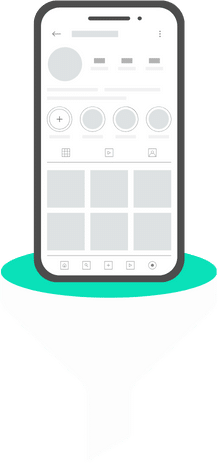Instagram has tons of data, as millions of people post pictures, videos, and stories every day. When we talk about scraping Instagram data, we mean pulling out this data using computer programs. This is really helpful for marketers, researchers, and people who analyze data, because it gives them information about how consumers behave, what’s trending, and how engaged people are.
Table of Contents
- Importance and Applications of Scraping Instagram Data
- What Do We Mean By Scraping Instagram Data?
- What Data Can You Scrape From Instagram without Logging in?
- Best Python IG Scrapers And Tools In 2024
- How To Scrape Instagram Followers?
- How To Scrape Instagram Profiles And Usernames?
- How To Scrape Instagram Hashtags?
- How To Scrape Instagram Comments?
- Is Scraping Instagram Data Legal?
- Can You Get Banned By Instagram For Scraping?
- How To Avoid Instagram Anti-Scraping Measures Using Proxies?
Importance and Applications of Scraping Instagram Data
The importance of Instagram scraping transcends various domains:
- Marketing: Marketers scrape Instagram to gather data on potential customers, track how certain posts perform, and analyze engagement with users. This data helps in refining marketing strategies, identifying influential users, and tailoring content to meet the audience’s interests.
- Research: Researchers analyze Instagram data to study social trends, understand public sentiment on various topics, and gain insights into digital culture. This can involve tracking the spread of information, the popularity of hashtags, or the impact of social media on public opinion.
- Analytics: Data analysts use Instagram data to create comprehensive reports on user engagement, content performance, and trend analysis.
The versatility of Instagram data makes it a critical resource for driving decisions and crafting targeted strategies.
What Do We Mean By Scraping Instagram Data?
Instagram scraping refers to the automated process of collecting data from Instagram without using the platform’s official API. This includes data such as user profiles, usernames, instagram followers, comments, and hashtags. Scraping can be done through various means, including custom-built scrapers in Python, third-party services, or tools designed specifically for Instagram data extraction.
In the following sections, we’ll dive deeper into the tools and techniques for scraping Instagram, address the legal and ethical considerations, and provide step-by-step guides for using Python to scrape Instagram data. Additionally, we’ll explore the challenges and limitations of scraping Instagram.
What Data Can You Scrape From Instagram without Logging in?
Scraping Instagram without logging in presents certain limitations due to Instagram’s policies on data access. However, with the right tools and techniques, you can still extract a variety of public data. Here’s a summary of the types of data you can scrape without needing to log in:
- Profiles: Public profiles can be scraped for information such as profile ID, username, full name, bio, external URLs, profile picture URLs, followers count, follows count, IGTV video count, highlight reel count, verified status, business account status, private account status, and related profiles.
- Posts: For public posts, you can extract data like post ID, caption, hashtags, post URL, shortcode, comments count, likes count, timestamp, mentions in the post, and image URLs.
- Hashtags: You can scrape the top 50 results related to specific hashtags, which might include related profiles and posts utilizing those hashtags.
- Comments: Up to 50 comments per post can be extracted, allowing for analysis of user engagement and sentiment.
- User and Place Searches: Although direct searches on Instagram require login, using external search engines like Google can provide access to profiles and places by bypassing the login requirement.
- Likes: While detailed information about who liked a post may not be accessible, the total count of likes on public posts can be scraped.
Best Python IG Scrapers And Tools In 2024
Instagram scraping leverages Python libraries to automate data extraction from Instagram profiles, comments, followers, and hashtags. This section compares popular tools and highlights their features, focusing on speed, reliability, and the types of data they can scrape.
Python offers several libraries and frameworks for Instagram scraping, each with unique features and capabilities. Some prominent libraries include:
1. Crawlbase
Crawlbase provides a comprehensive API for crawling and scraping Instagram data. It is versatile, allowing users to extract various types of data, including profile information, posts, and hashtags. The Crawlbase Crawling API facilitates the scraping process by handling requests to Instagram pages and returning the raw HTML content or JSON data for further processing.
2. Selenium with Selenium-Stealth
This combination is powerful for scraping dynamic content from Instagram that requires interaction or simulating a real user browsing experience. Selenium-Stealth enhances Selenium’s capabilities by evading detection mechanisms, making it an excellent choice for scraping Instagram profiles, followers, and posts. A typical setup involves configuring a Chrome driver with specific options to mimic browser behavior, including the use of instagram proxies and user-agent rotation.
Comparison of Popular IG Scrapers
When comparing these tools, consider the following aspects:
- Speed and Efficiency: Crawlbase is highly efficient for bulk scraping tasks, offering a straightforward API that returns structured data. In contrast, Selenium, combined with Selenium-Stealth, is slower due to the overhead of simulating a browser but provides a higher level of interaction with web pages.
- Reliability and Detection Avoidance: Selenium-Stealth has the advantage of mimicking real user behavior more closely, reducing the risk of being blocked by Instagram’s anti-scraping measures. Crawlbase also offers robust scraping capabilities, with built-in features to handle common scraping challenges.
- Data Types and Flexibility: Crawlbase excels in extracting a wide range of data types through its specialized scrapers for posts, profiles, and hashtags. Selenium, while more manual in its approach, allows for custom scripts that can extract almost any data visible on the Instagram interface.

How To Scrape Instagram Followers?
To scrape Instagram followers, you generally have two approaches depending on your technical skills and preferences
1. Scraping Instagram Followers Using Web Scraping Techniques
This involves writing scripts that automate the process of accessing Instagram profiles and extracting data about followers. Here’s a generalized approach:
- Preparing Your Browser: Use tools like Selenium combined with a browser driver (e.g., ChromeDriver) to simulate a real user browsing Instagram. This step might involve setting up the browser with options like Instagram proxies and user agents to avoid detection and blocks by Instagram.
- Fetching Data: Build a URL with the specific Instagram user’s profile appended with parameters to directly access the JSON data Instagram uses to load profile information on the frontend. This URL is used to fetch data about followers without parsing the HTML content.
- Data Extraction and Parsing: Once you have the JSON data, you can parse it to extract information about followers, such as their usernames, full names, follower counts, and other publicly available data. Tools like JSON parsing libraries in Python can be handy for this step.
2. Scraping Instagram Followers Using Instagram’s GraphQL API
Instagram uses GraphQL for data queries, which can be leveraged to fetch followers’ data by constructing the right query.
- Constructing the Query: You’ll need to craft a query with the user’s ID, specifying the number of followers to fetch and any pagination cursors if you’re retrieving data in batches.
- Sending the Request: Utilize HTTP libraries (e.g., requests in Python) to send the query to Instagram’s GraphQL endpoint. Include the necessary headers and parameters, such as the Instagram App ID, to authenticate your requests.
- Handling the Response: The response will be in JSON format, containing data about the user’s posts, comments, likes, and followers. You’ll need to parse this response to extract the required information about the followers.

How To Scrape Instagram Profiles And Usernames?
To scrape Instagram profiles and usernames, you can use Python with the httpx library for making requests and jmespath for parsing JSON responses. The process involves querying Instagram’s backend API endpoint without logging in to fetch user data. You’ll need to set up your request with appropriate headers, including “x-ig-app-id” for Instagram’s backend app ID. This method allows you to scrape user data such as biography, follower count, and profile pictures.
How To Scrape Instagram Hashtags?
To scrape Instagram hashtags, you generally follow these steps:
- Choose Tools: Use Python with libraries like requests or httpx for web requests and BeautifulSoup or lxml for parsing HTML. Alternatively, explore Instagram’s GraphQL API for a more direct approach.
- Identify Hashtag URLs: Construct the URL for the hashtag page. Instagram uses a predictable URL pattern for hashtags, typically https://www.instagram.com/explore/tags/[hashtag]/.
- Make Requests: Use your chosen HTTP library to send requests to the hashtag URL. Handle rate limits and use proper headers to mimic a browser request.
- Parse the Response: Extract the relevant data from the HTML or JSON response. For HTML responses, look for script tags containing JSON data about the posts.
- Extract Data: Focus on extracting the desired information such as post URLs, image links, captions, and user information. Use JSON parsing for API responses or HTML parsing for web scraping.
- Handle Pagination: Instagram loads more posts as you scroll. Use the GraphQL API or simulate scrolling by finding and using the next page token/URL from the initial response.
- Store and Process Data: Save the extracted data in a structured format like JSON, CSV, or a database. Process the data according to your needs.
How To Scrape Instagram Comments?
To scrape Instagram comments, you’d typically use a similar approach as scraping other Instagram data, focusing on accessing the specific endpoints that return comment data. This involves making requests to Instagram’s GraphQL API, using the post’s shortcode to retrieve its comments. You’ll need to handle pagination to fetch all comments, as they may not all be returned in a single response. Properly parsing the JSON response will allow you to extract comment text, commenter usernames, and other relevant information.
Is Scraping Instagram Data Legal?
While scraping public Instagram data can be legal, it’s essential to navigate the legal, ethical, and technical challenges carefully. Always ensure your scraping activities align with Instagram’s ToS, consider the ethical implications of your data collection, and stay informed about relevant legal developments in your jurisdiction.

Can You Get Banned By Instagram For Scraping?
Yes, Instagram can ban users for scraping. Instagram’s Terms of Use prohibit automated data collection methods without explicit permission. They have measures to detect and block scraping activities, including:
- Rate Limiting: Restricting the number of requests from a single IP address.
- Behavioral Analysis: Identifying non-human traffic patterns, such as rapid page requests.
- CAPTCHAs: Presenting challenges to verify if the user is human.
If Instagram detects scraping behavior, it may:
- Temporarily block the IP address.
- Require CAPTCHA verifications.
- Suspend or permanently ban the account involved.
How To Avoid Instagram Anti-Scraping Measures Using Proxies?
Instagram has sophisticated mechanisms to detect and block scraping activities. Here are strategies to avoid Instagram’s anti-scraping measures using proxies:
1. Use Residential Proxies
Residential Instagram proxies assign IP addresses that belong to real devices. This makes your requests appear as if they come from different genuine users, reducing the risk of detection and banning. A proxy pool allows you to have a large set of IP addresses at your disposal, which you can cycle through. This decreases the likelihood of any single proxy being flagged for suspicious activity.
2. Rotate Proxies
Rotate your proxies regularly to mimic the behavior of multiple users. Constantly using the same IP address for large volumes of requests can trigger Instagram’s anti-bot mechanisms.
3. Limit Request Rate
Rate limiting your requests is crucial. Making too many requests in a short period can lead to temporary or permanent IP bans. Implement delays between your requests to mimic human behavior more closely.
4. Implement User-Agent Rotation
Changing the user-agent on each request can further disguise your scraping activities. This simulates requests coming from different browsers and devices.
5. Use Headless Browsers Wisely
Headless browsers are powerful for scraping dynamic content but can be easily detected. Combine them with proxy rotation and user-agent spoofing to minimize detection risks.
6. Avoid Scraping Instagram During Peak Hours
Performing Instagram scraping activities during off-peak hours can reduce the chances of detection, as sudden spikes in traffic from a single IP address during busy times are more suspicious.
7. Keep Up with Instagram’s Terms of Service
Instagram periodically updates its terms of service. Staying informed about these changes can help you adjust your scraping practices to remain compliant and reduce the risk of being banned.
Related articles:
- Tags:
- how to scrape, Instagram proxies, python, web scraping


